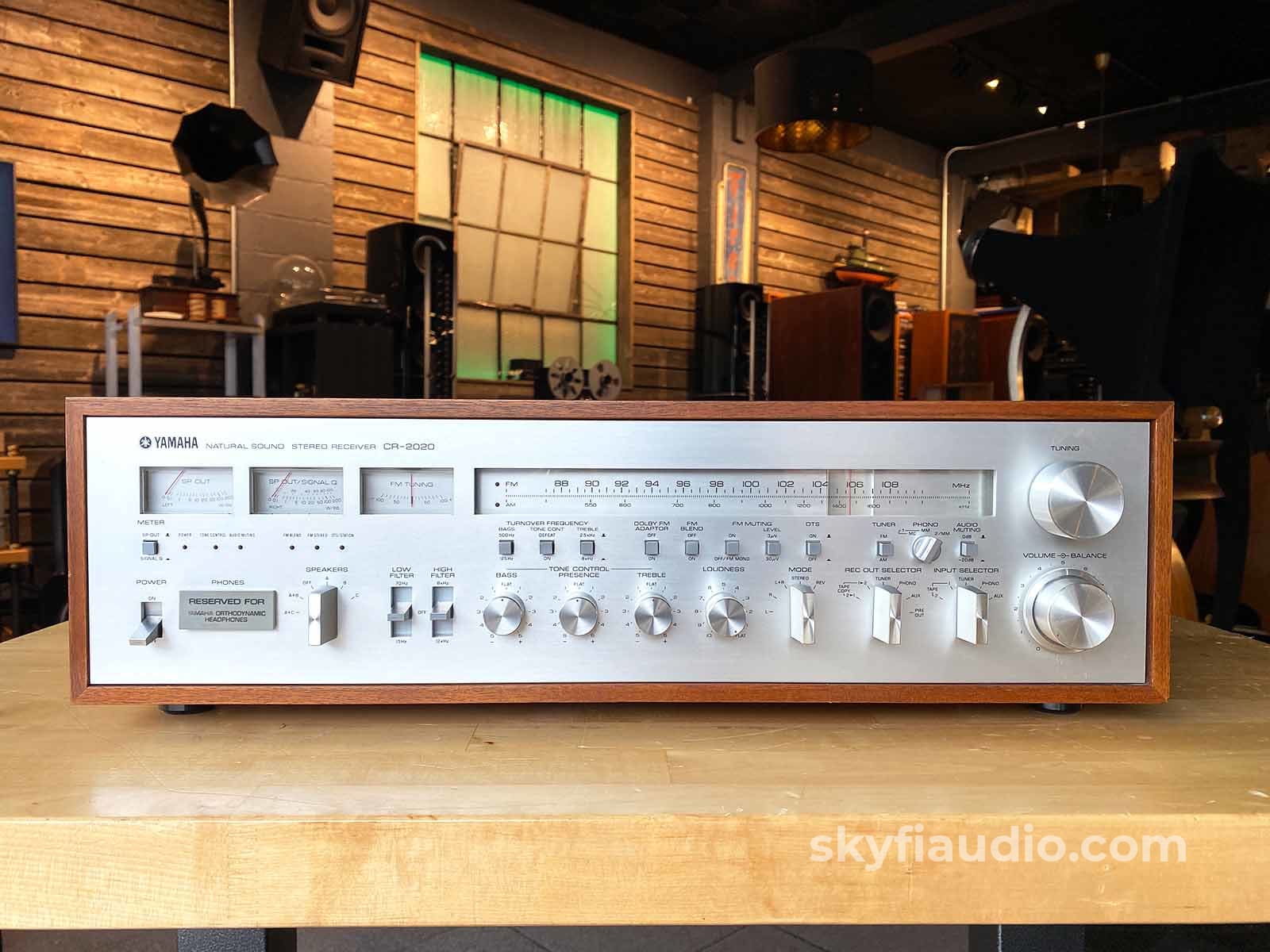
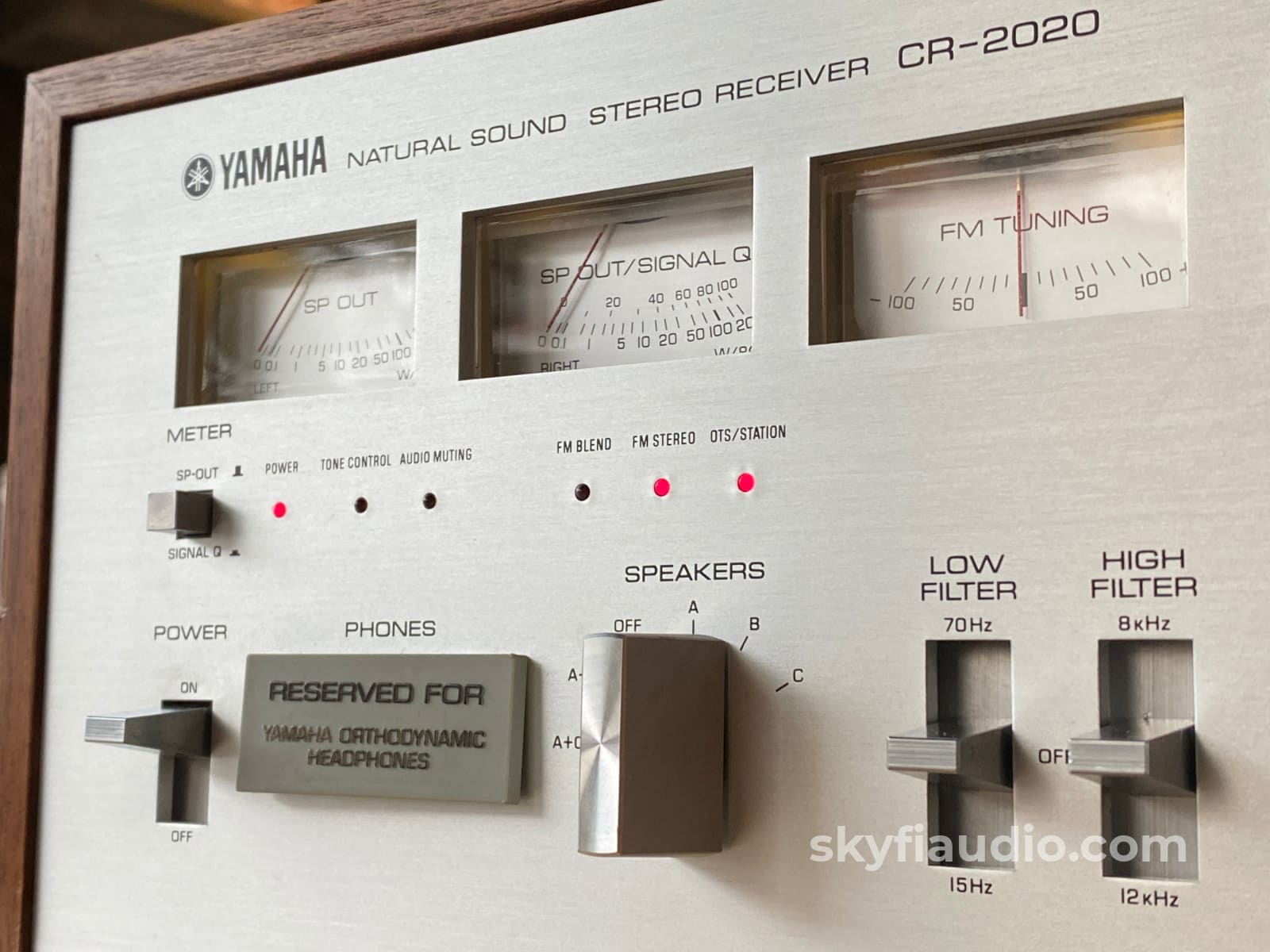
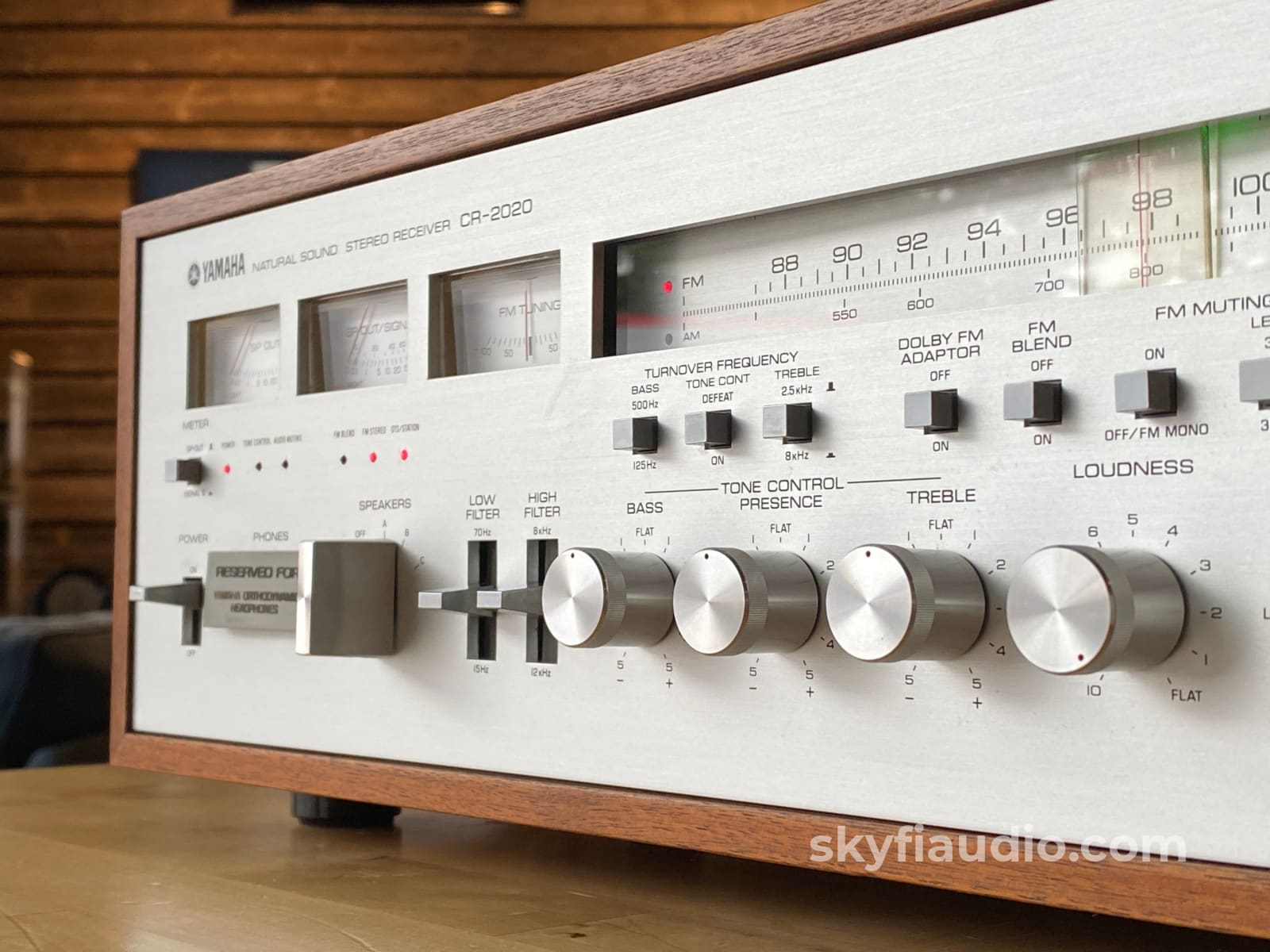
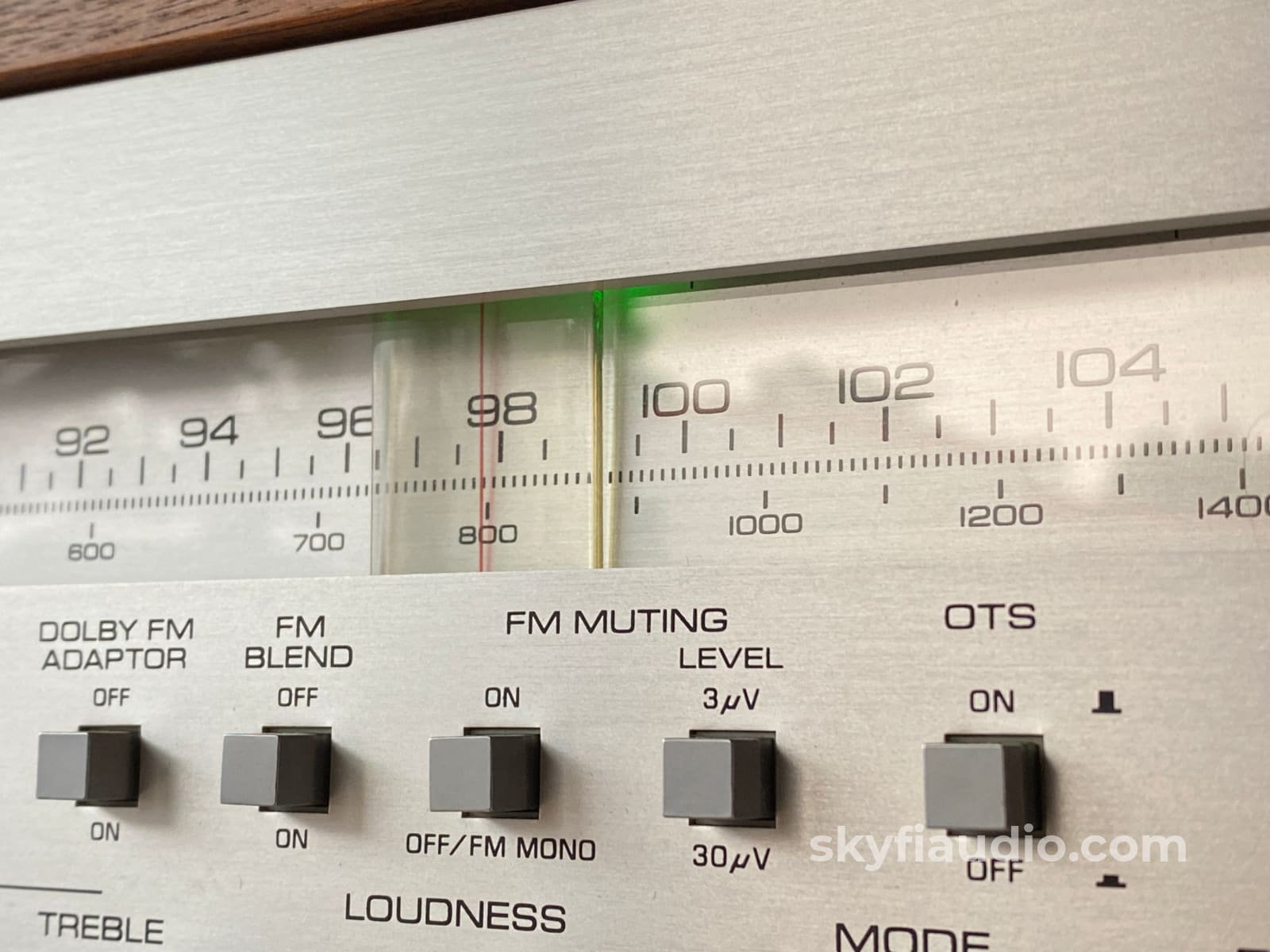
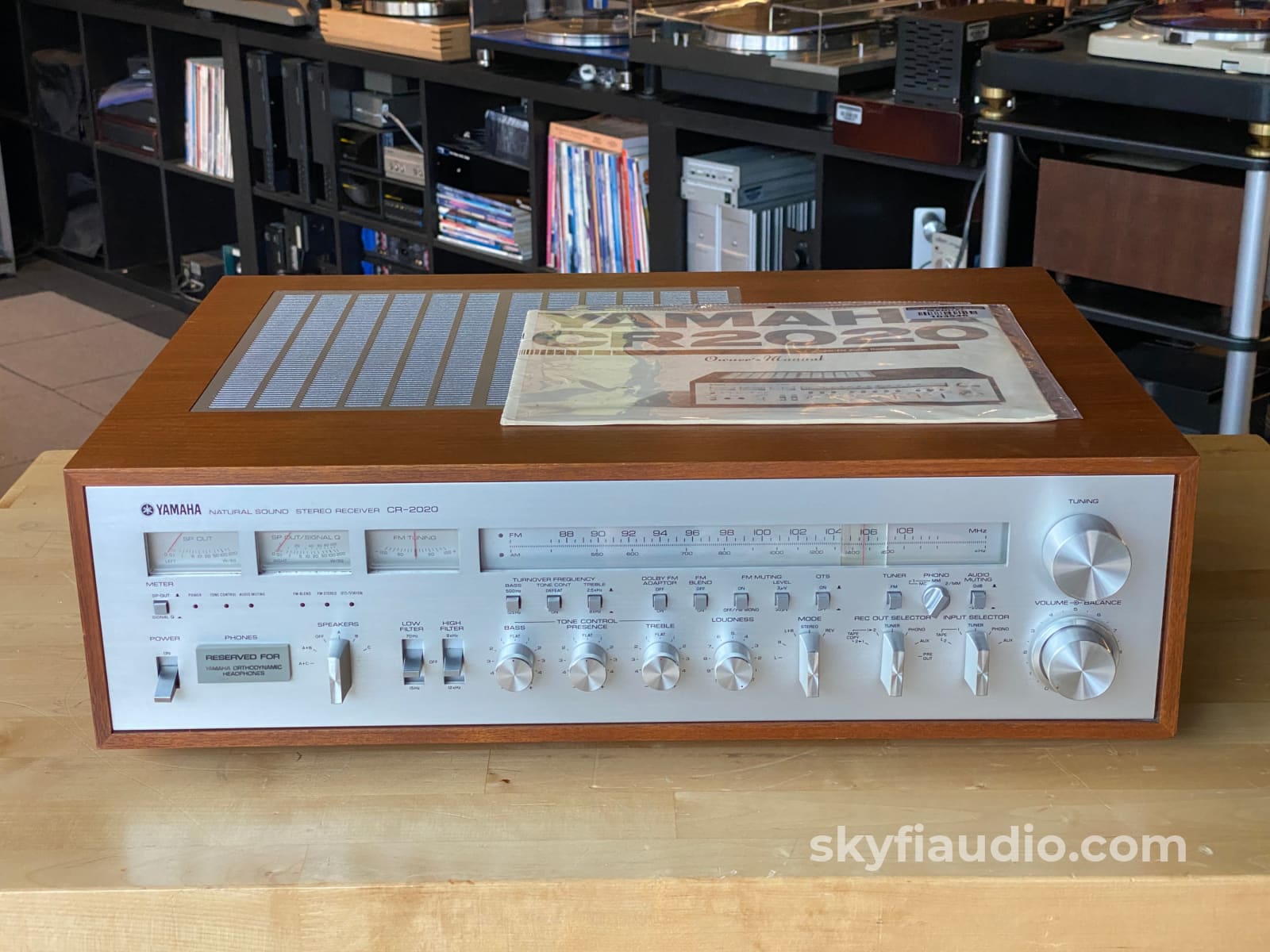
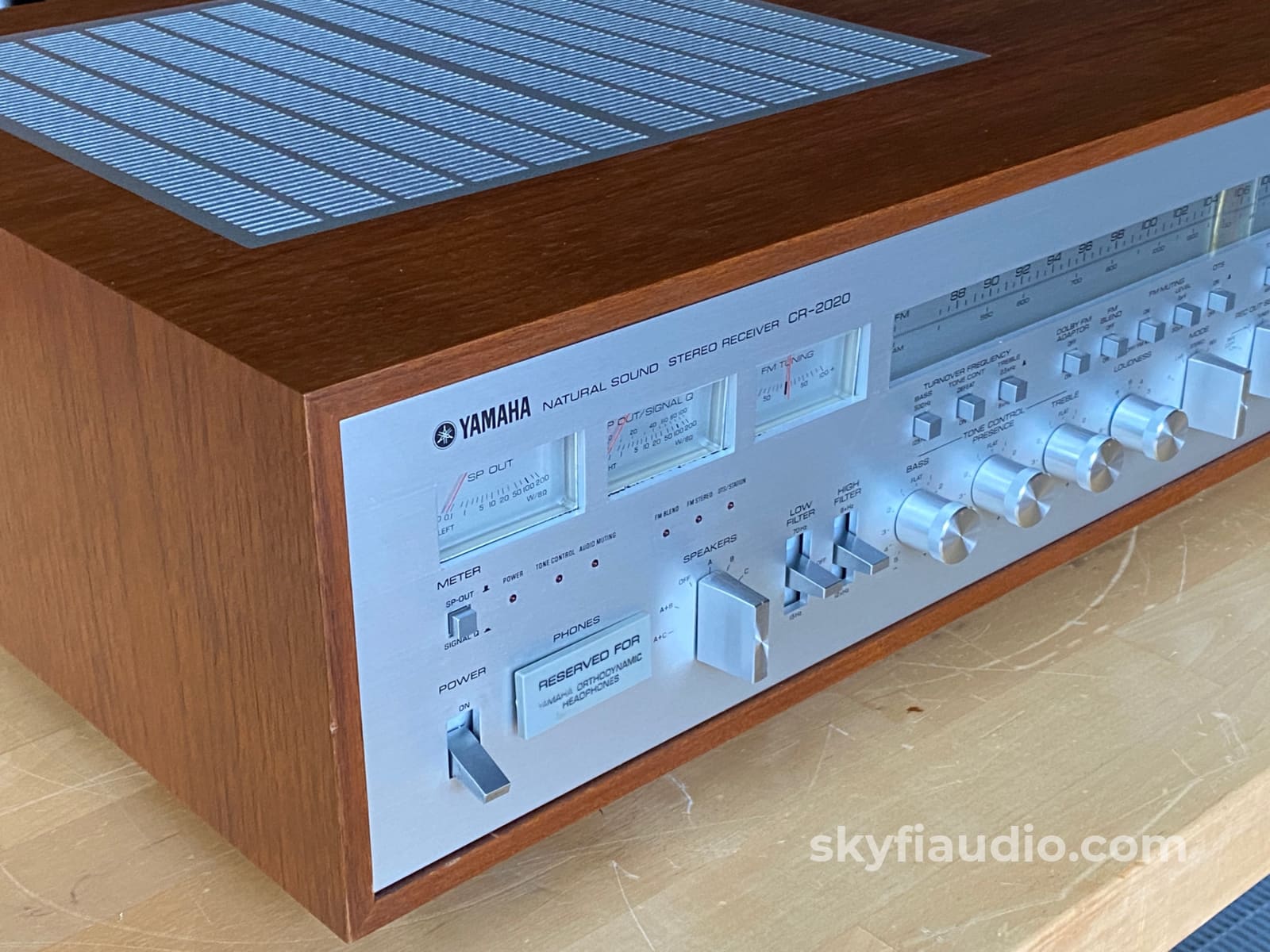
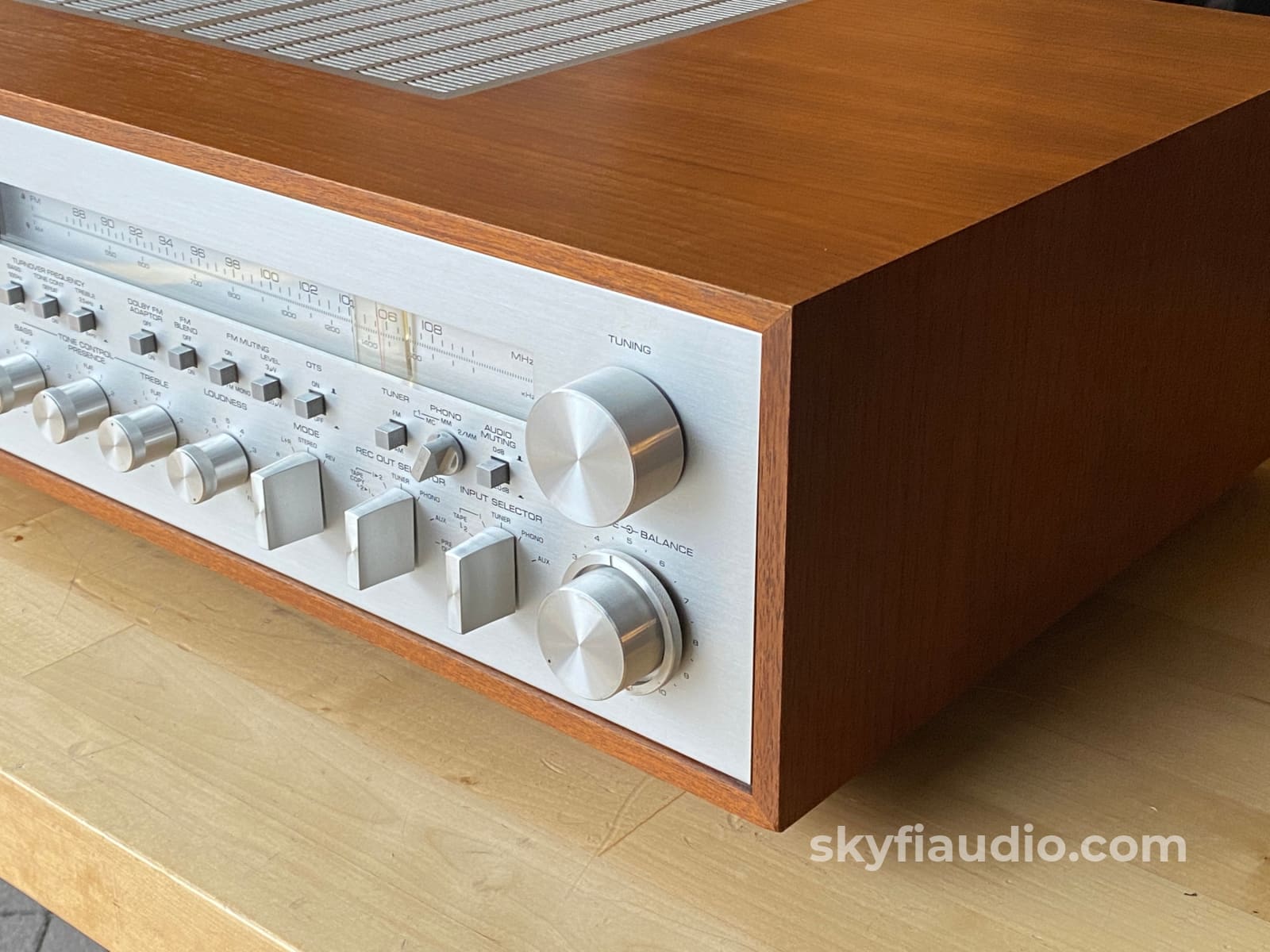
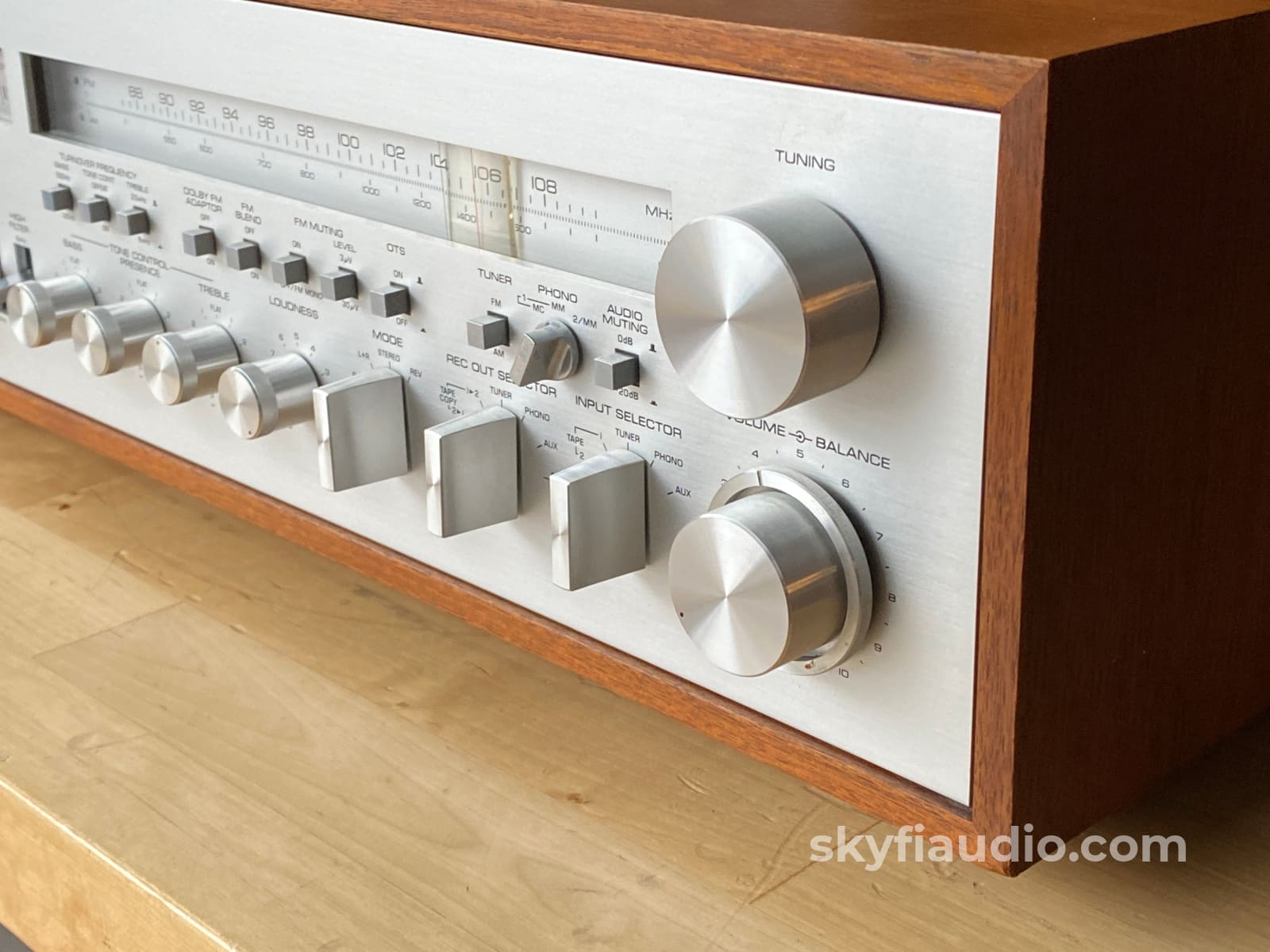
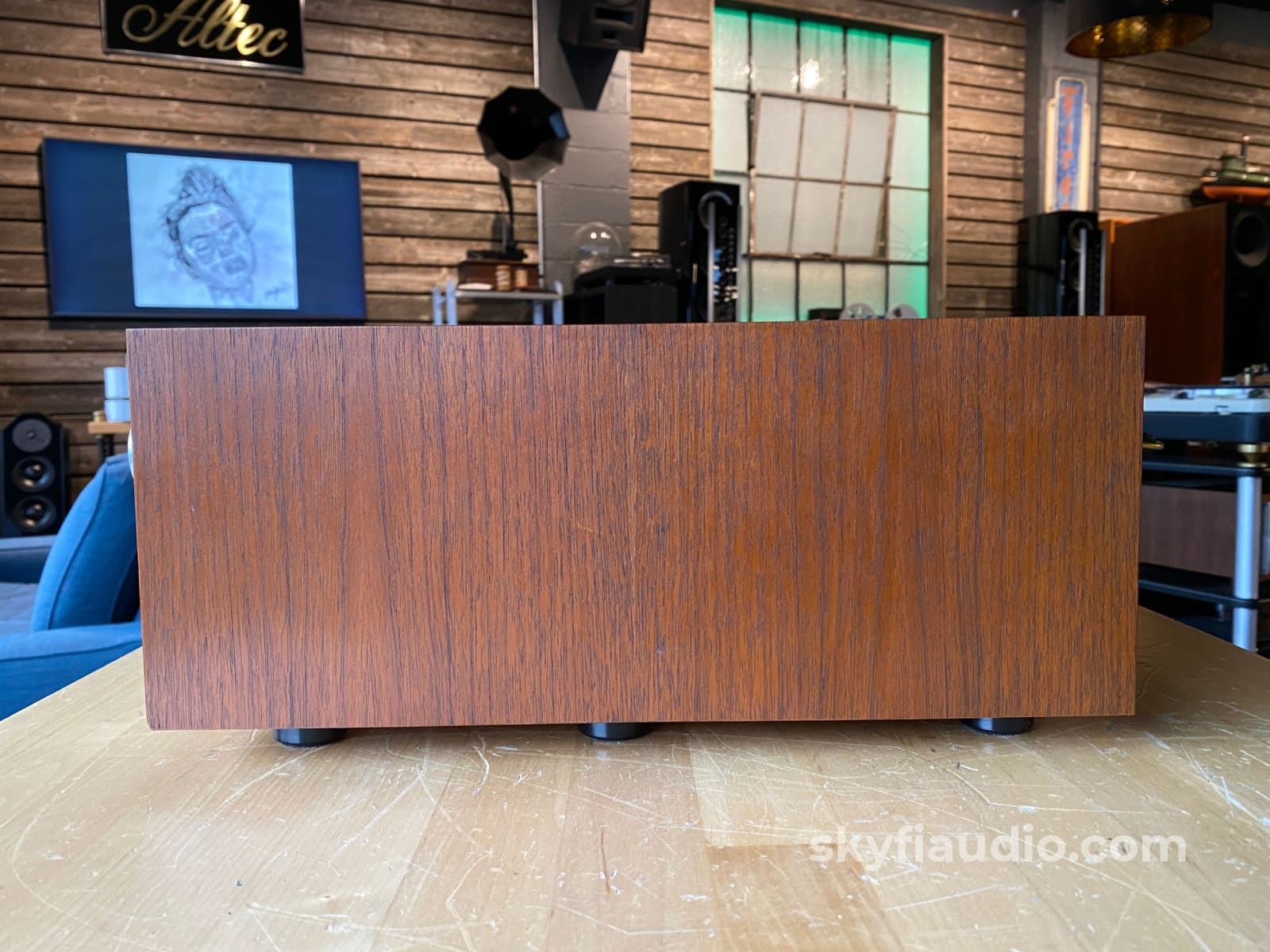
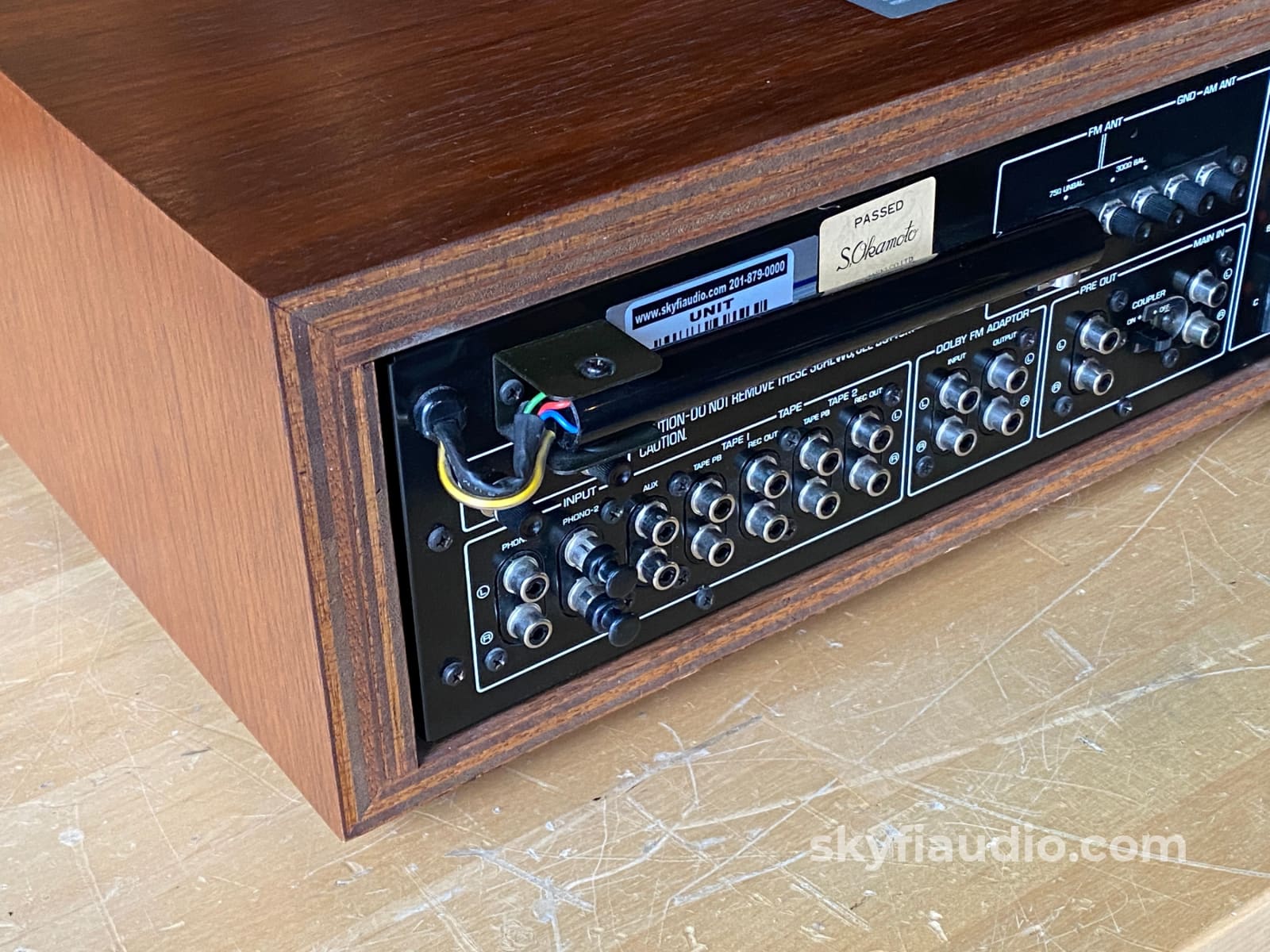
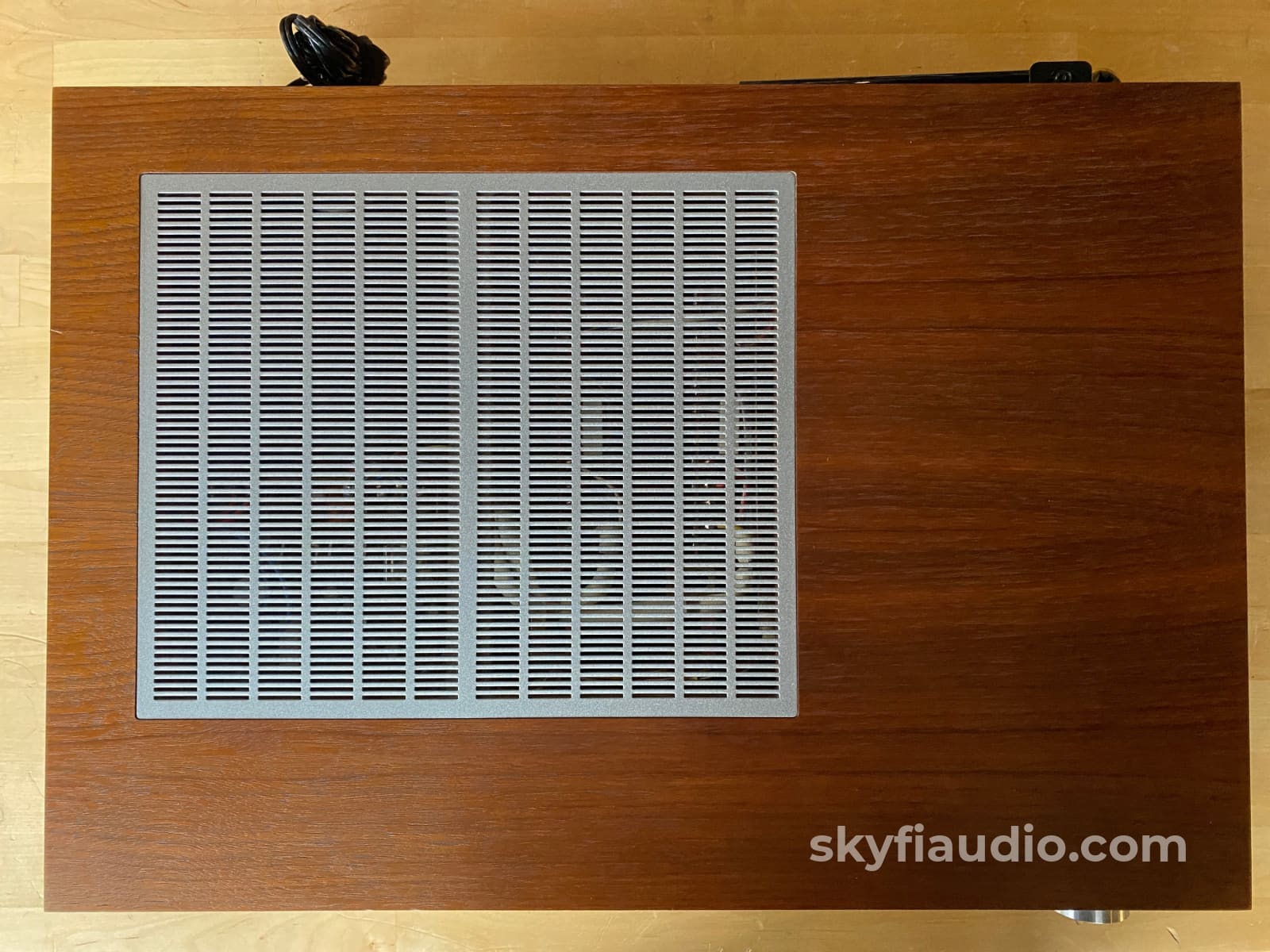
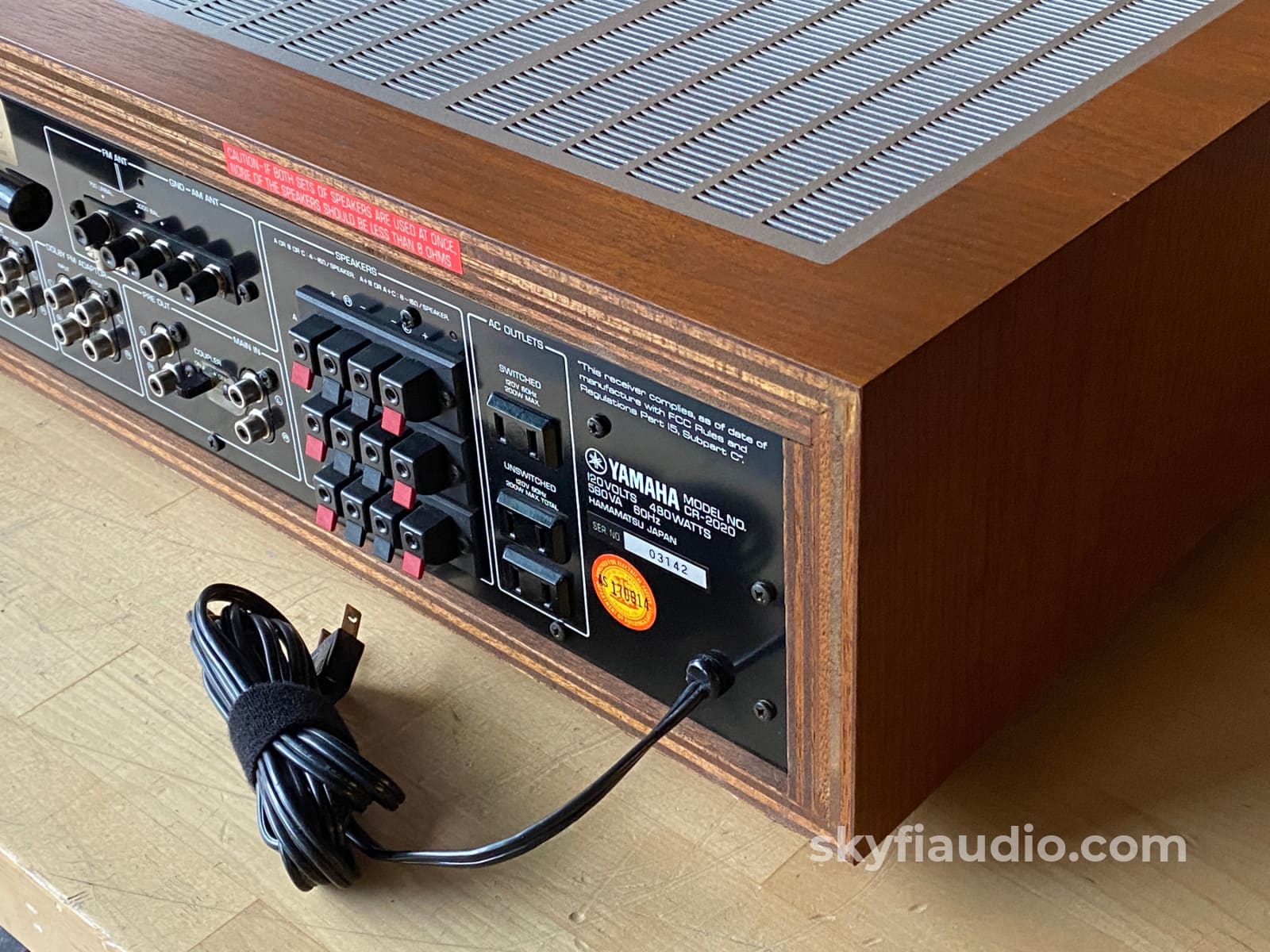
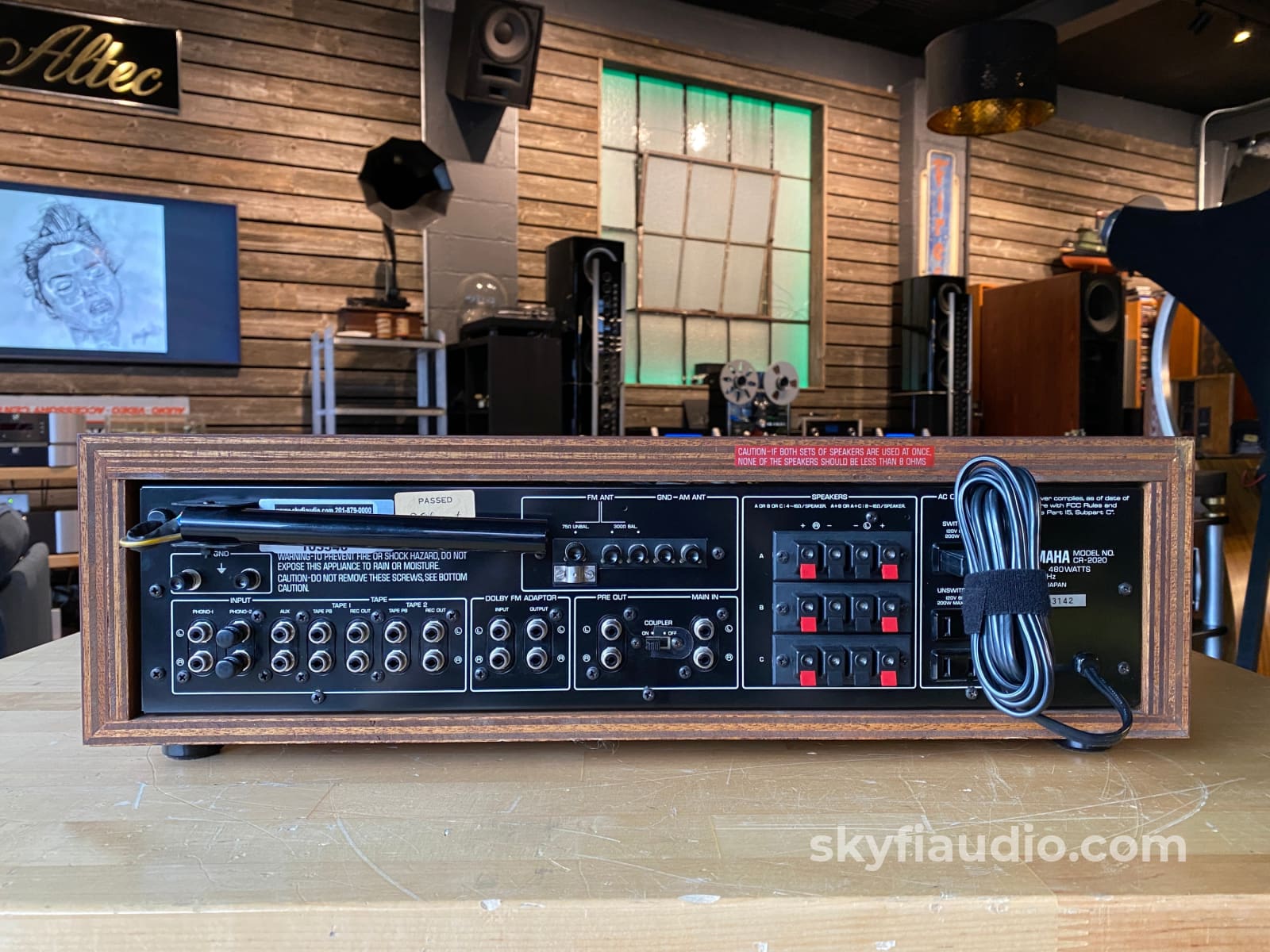
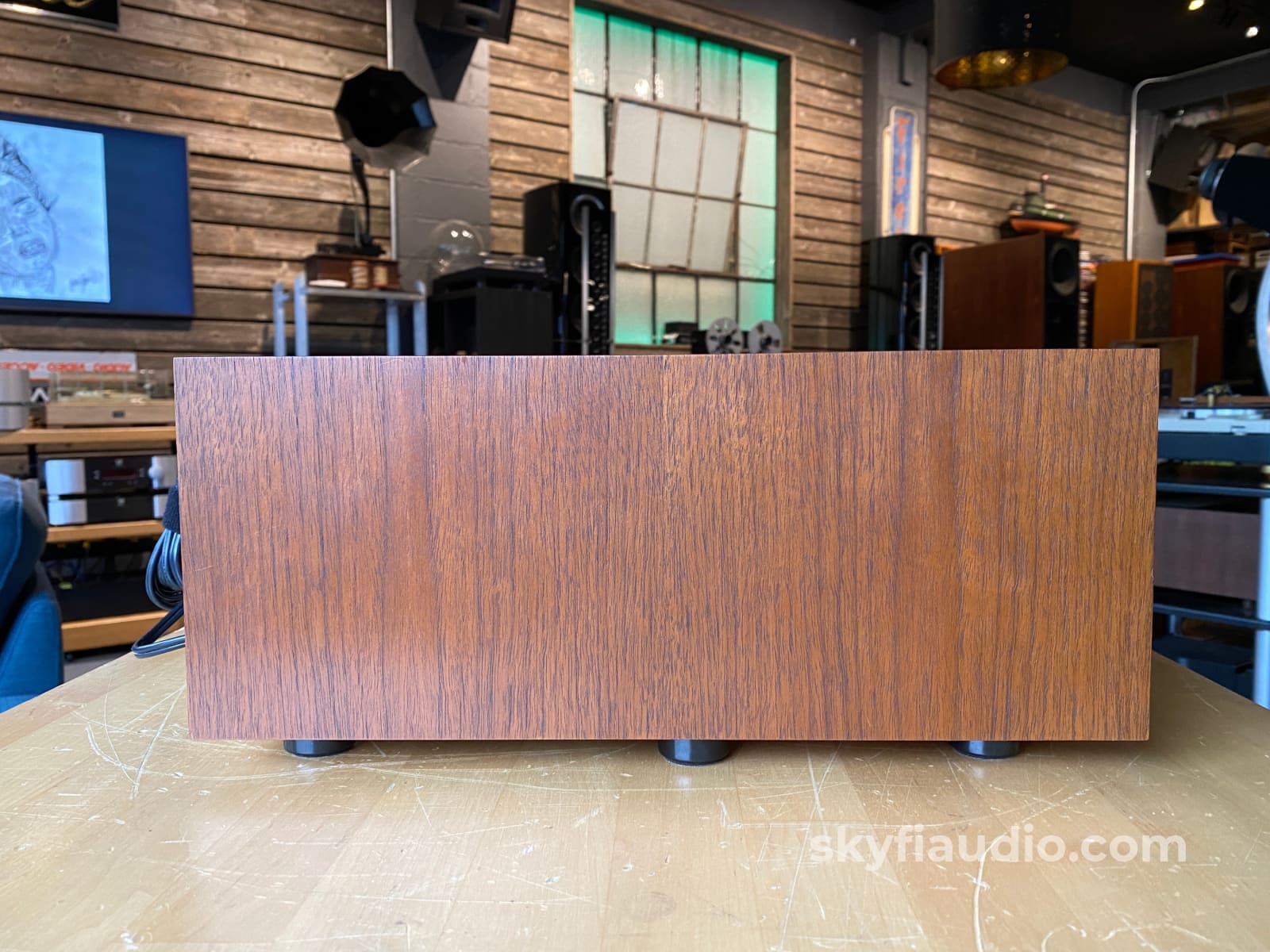
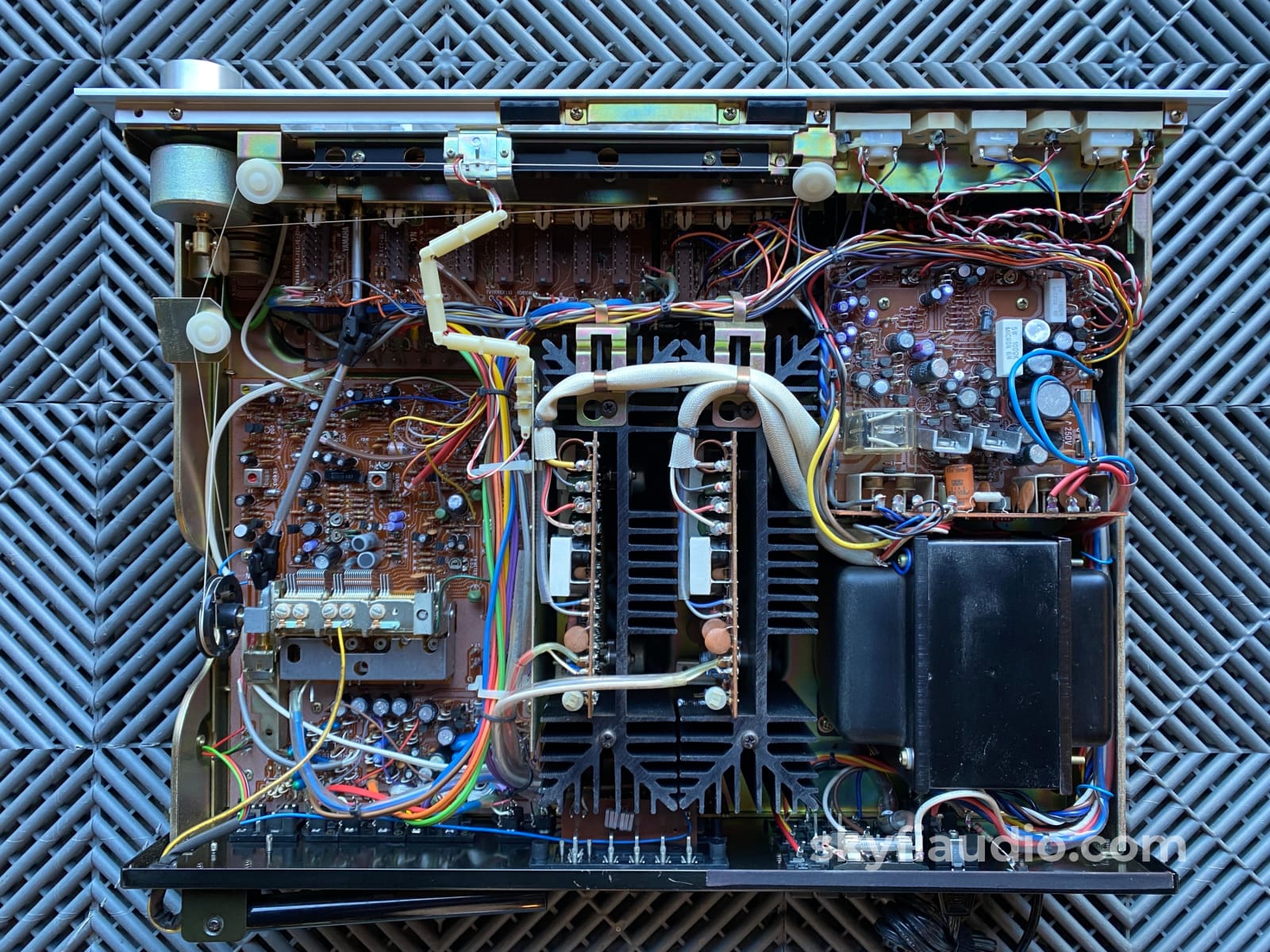
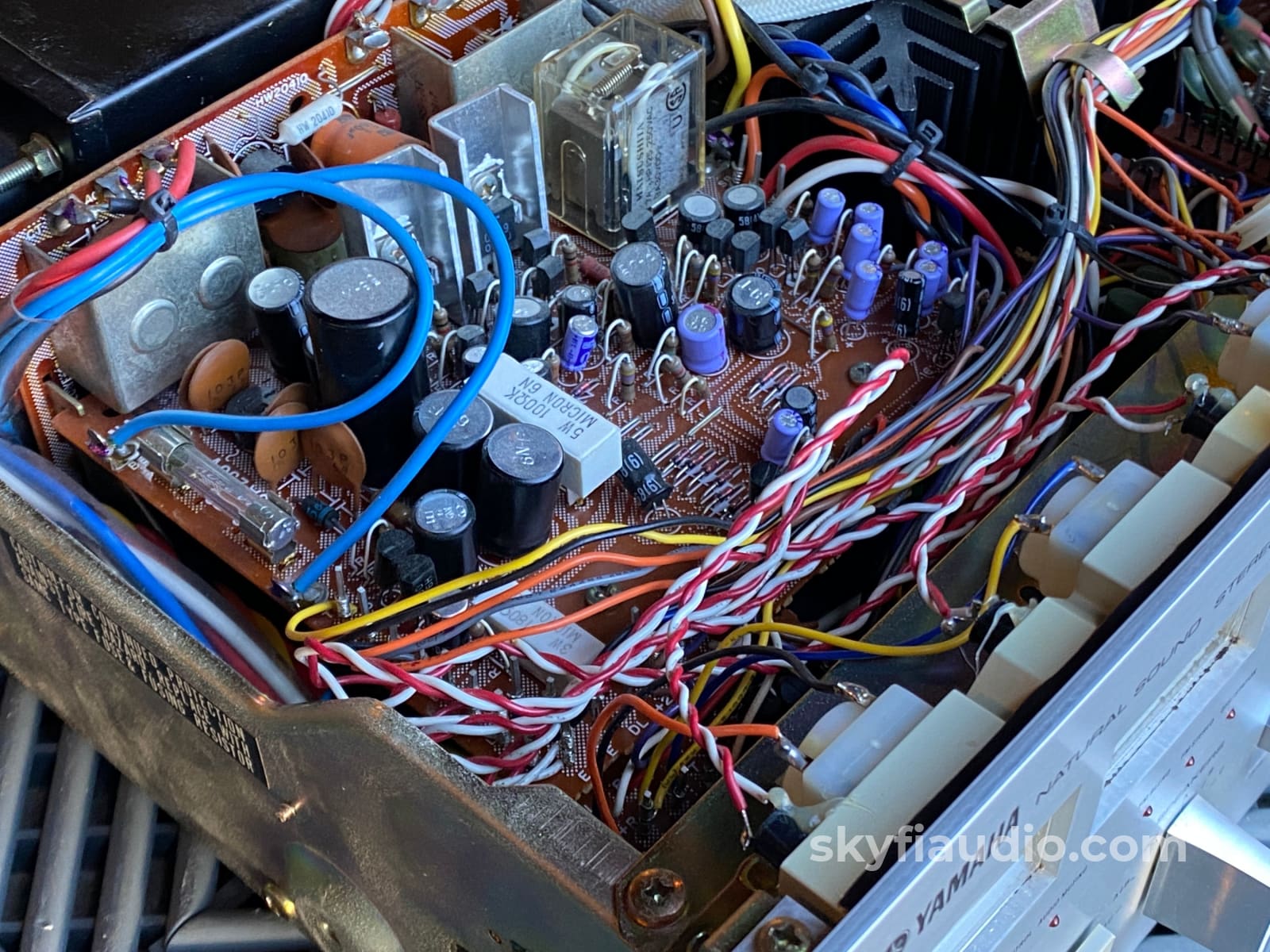
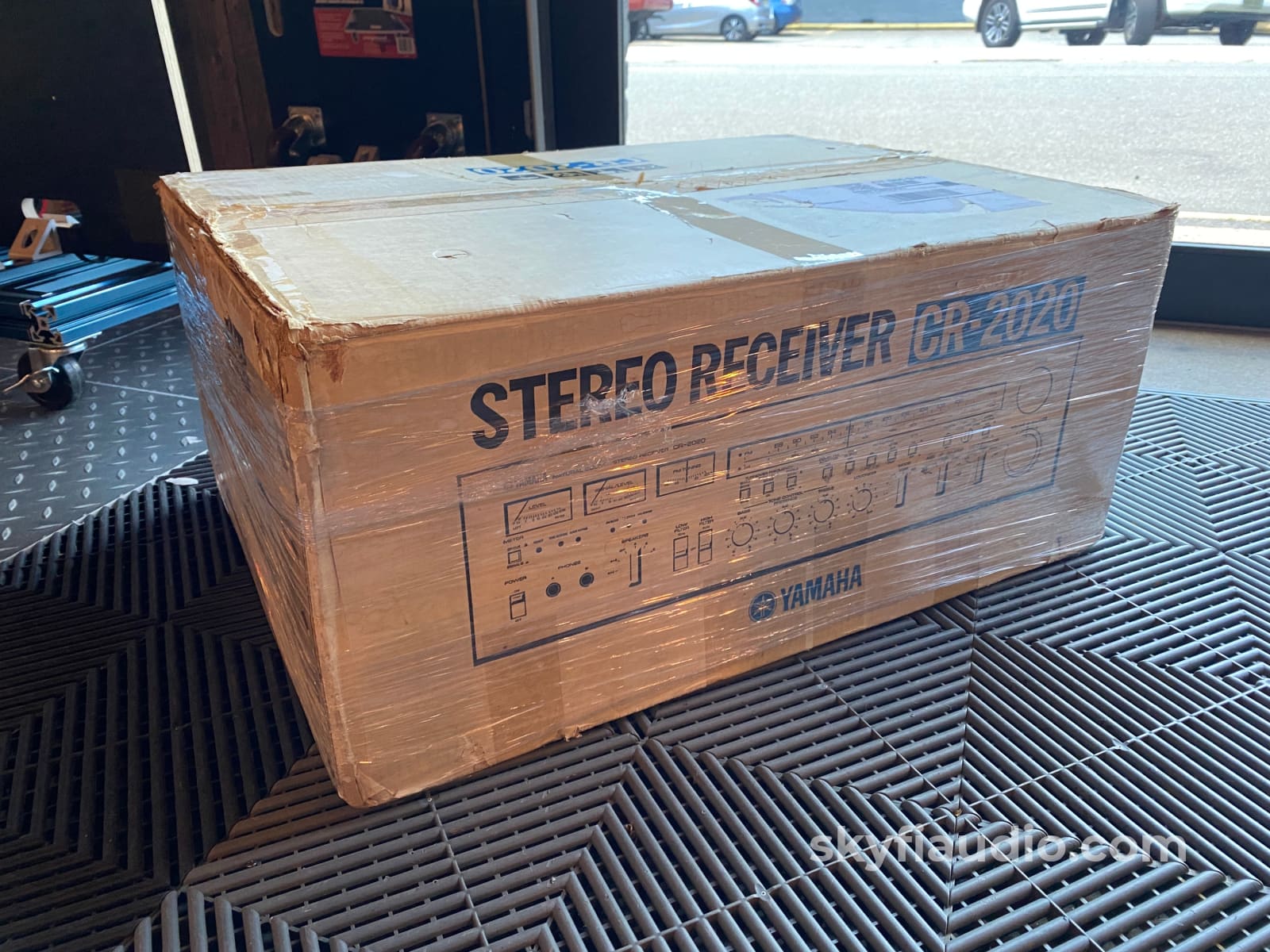

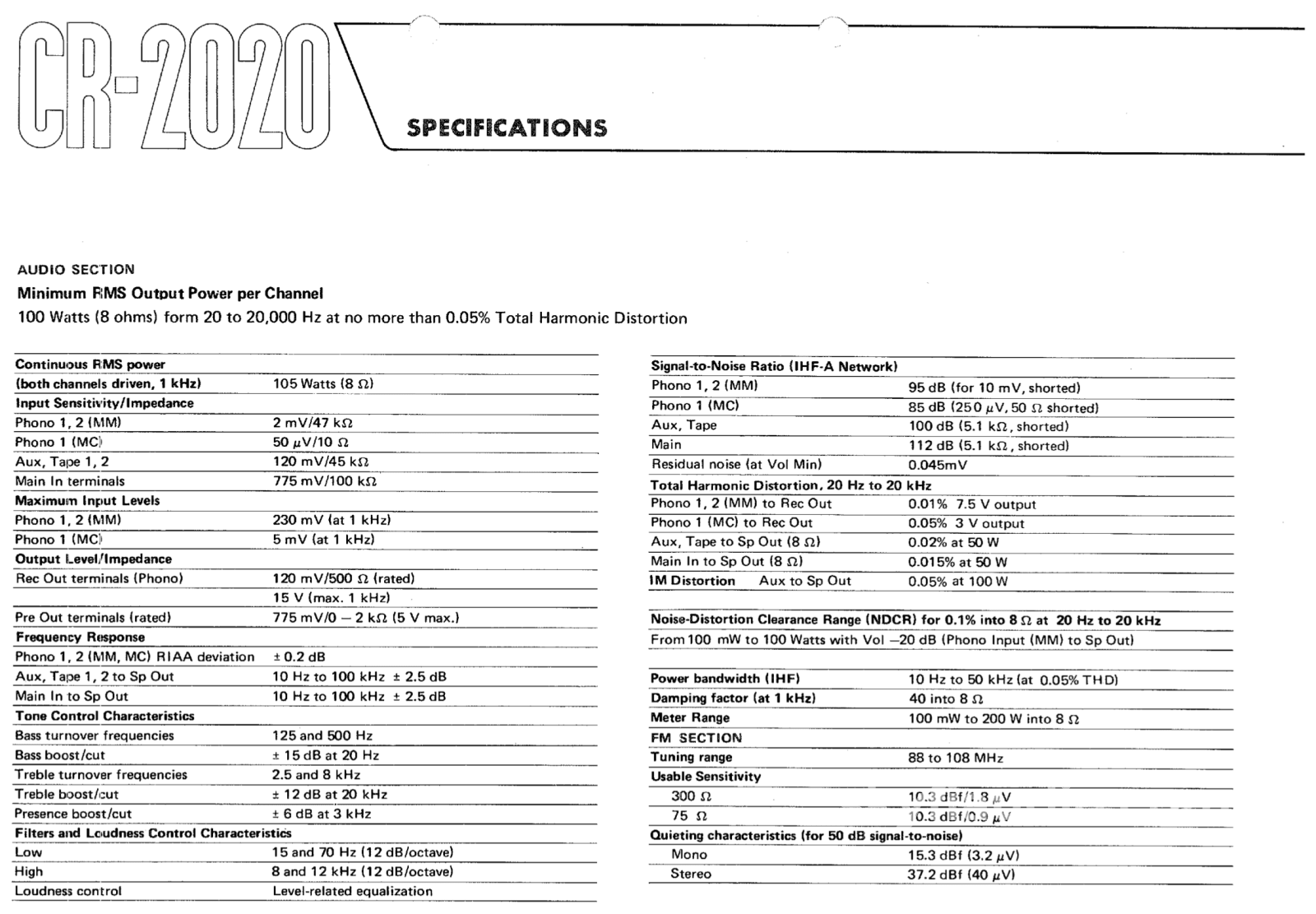
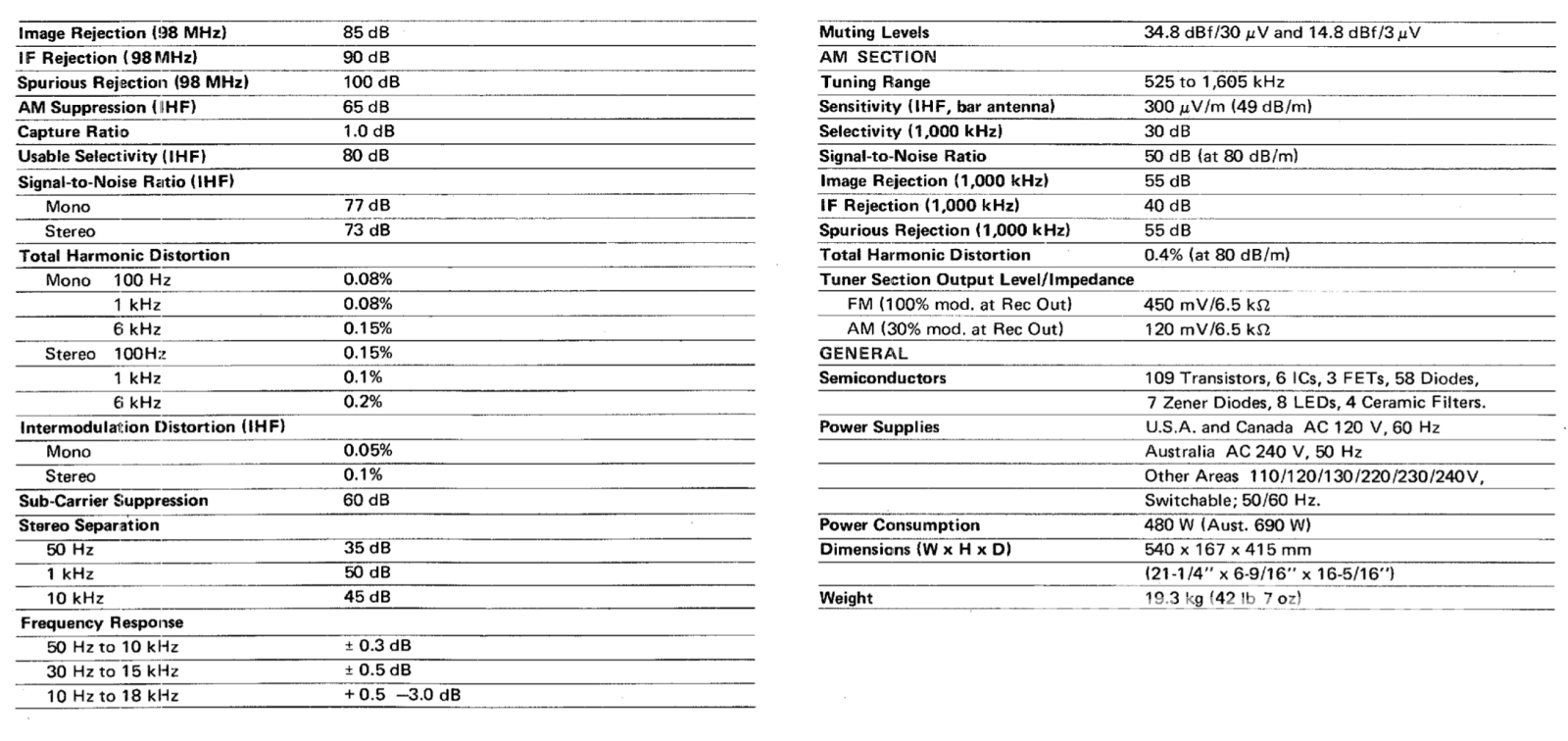
Yamaha CR-2020 Survivor Vintage Receiver w/MC Phono
Free Shipping on Most Electronics - Excludes Speakers and Items Requiring Freight - Contiguous U.S. Only
Pickup currently unavailable at SkyFi 479

Yamaha CR-2020 Survivor Vintage Receiver w/MC Phono
SkyFi 479
479 South Broad Street
Glen Rock NJ 07452
United States
This beautiful collector grade example of the Yamaha CR-2020 is in all original condition aside from the lamps which were replaced at some point in the past.
The meter lamps are incandescent while the dial pointer has been changed to a green LED.
This CR-2020 underwent a full and thorough checkup at our bench which involved cleaning the preout/main in switch, and touching up the tuner alignment and bias.
This receiver tests clean to rated power with excellent channel balance and frequency response.
This piece is being sold as a "survivor." Meaning it's currently fully functional but additional preventative maintenance related to the power supply is advisable if this will see long-term everyday use.
Click below to add our recommended matching cables from Kimber Kable, all brand new as SkyFi is an official Kimber dealer.
Kimber Kable - RCA Interconnects - Better
Kimber Kable - RCA Interconnects - Best
Kimber Kable - Phono Interconnects - Better
Kimber Kable - Flagship Tonearm Interconnects - Best
Kimber Kable - Speaker Cables - Good
Kimber Kable - Speaker Cables - Better
More from Yamaha:
You probably know that Yamaha offers one of the world's most powerful and complete ultra low distortion home audio component systems. It's also one of the most expensive.
But with the CR-2020's excellent cost performance you get many of the unique features developed for the spare no expense audiophile.
The CR-2020 is part of a new series of Yamaha audio components created for one key purpose: to provide distortion free natural sound in your home under real listening conditions.
To realize this goal we had to create a whole new method of measuring performance Noise Distortion Clearance Range. What does it show? NDCR is a range, the whole range of powers for which total harmonic distortion and noise are below a given level.
It requires that all pertinent measurements be made under actual listening conditions; through all amplification circuits used in actual listening (i.e., Phono Input to Speaker Out), and at the volume control settings preferred for normal listening levels.
Up to now distortion has usually been measured for only part of the amplifier circuitry (main amp, equalizer amp). What's more, this measurement has usually been made at maximum volume setting. But components which perform well at this level often show remarkably inferior signal to noise, distortion and even frequency response characteristics at realistic listening levels.
That is why Yamaha's Noise Distortion Clearance Range is measured at -20 dB volume setting rather than the conventional 0 dB: the performance ratings you see represent the actual in home sound you hear, not simply test bench figures. The actual NDCR range for the CR-2020 is a superb achievement in distortion free performance: 100 mW to 100 W.
Translated into home listening, think of it this way: if you set your volume control for most normal listening, average power to your speakers will be 1-2 watts. A pianissimo passage in this case will be approximately 100 mW. So the full NDCR range achieved by the CR-2020 means superb, pure fidelity in every conceivable listening situation.
To us at Yamaha NDCR is more than just a measurement. It reflects the design approach to all our music products. Because we pay such close attention to their sound in actual use, our engineers developed this assessment method to help build in the same tonal response for home audio enjoyment.
Please see our last photos of the manual linked below for full specifications:
|
Item |
Included |
|
Original Box |
Yes Included |
|
Manual |
Yes Included |
|
Remote |
Not Applicable |
|
Cables |
Yes - Power Only |
|
Physical Condition (Info Here) |
8 / 10 |
|
Working Condition |
10 / 10 |
The SkyFi Testing Process for Preamplifiers:
We start with a visual inspection of all internal components to make sure that there are no signs of heat stress or damage. Capacitors are checked for telltale signs of predictive failure including bulging, shrunken wrappers, or physical leakage. We also inspect the PCBs for discoloration from resistors or transistors that may have been running hot. On vintage units we often spot check select capacitors for value and ESR.
When we first power on a preamplifier we connect its RCA output to a Sencore PA81 Power Analyzer which simulates real world loading conditions and gives us an oscilloscope interface. The first order of business is checking that the volume control works smoothly throughout its entire range with acceptable channel balance. This is accomplished by feeding a 1KHz sine wave into one of the preamp’s line level inputs while monitoring the preamp’s output on an oscilloscope. We then switch to a 1KHz square wave to test the tone controls, loudness function, and filters where applicable. During this step we are watching for equal alteration of the test signal by both channels. This also helps us identify dirty controls that will need treatment. Once the basic line stage functions are verified, we test each input individually. This is especially important for devices that use relays to select their sources. If the preamp is equipped with a phono stage we test that as well. We use an inverse RIAA filter which allows us to feed a reference test signal into the phono input with the proper RIAA equalization and level. A square wave or sine sweep is used to verify that the device’s phono stage is faithfully reproducing the RIAA curve. If the preamp under test has balanced inputs and/or outputs these are tested as well.
We finish up our bench testing with a listening test with our bench amplifier and reference speakers. During this test we check for hum or hiss that may not have shown up in earlier testing. We also check that all of the tone controls and filters perform as expected. If the preamplifier has remote control functions these are also tested. Preamps with tube circuits or complicated power supply topologies are connected at our long term test rig for extended stress testing under real world conditions.
The SkyFi Testing Process for Solid State Amplifiers:
We start with a visual inspection of all internal components to make sure that there are no signs of heat stress or damage. Capacitors are checked for telltale signs of predictive failure including bulging, shrunken wrappers, or physical leakage. We also inspect the PCBs for discoloration from resistors or transistors that may have been running hot. On vintage units we often spot check select capacitors for value and ESR.
If the amplifier passes visual inspection, we move on to a controlled power on sequence using a Sencore safety analyzer to monitor current draw in real time. Once the amplifier is determined to be safe to operate, we connect it to full AC mains for function and power testing. We connect the speaker outputs of the amplifier to a Sencore PA81 Power Analyzer which acts as a dummy load, DC offset monitor, and oscilloscope interface. We start with a low level 1KHz test signal at the amplifier’s input and slowly increase its amplitude while monitoring the output on an oscilloscope for signs of noise, clipping, distortion, or improper channel balance. We continue increasing the signal level until the amplifier reaches clipping. At this point we take an output power measurement and compare it to the spec sheet of the amplifier to verify proper performance. If the device under test has both balanced and single ended inputs they are both tested at this time. We finish off the bench evaluation with a 1KHz square wave check and a 20Hz to 20KHz sine sweep to assess the amplifier’s frequency response characteristics. This battery of tests will usually reveal if the amplifier has any issues that need further attention.
Before the device leaves the bench, we perform a listening test with actual music using a variety of preferred test tracks. Our benches are outfitted with familiar monitor speakers which help us identify inconsistencies that will not always show up on our test gear. The main things that we are listening for are hum or noise with no signal present, proper center image, clicks, pops, or any other obvious undesirable audio characteristics.
If the unit passes all of these tests it is moved to our long term testing rig where we simulate real word operating conditions for 6-8 hours. This allows us to monitor the unit for signs of thermal runaway or intermittent issues that only crop up when the unit has fully come up to temperature.
The SkyFi Testing Process for Tuners:
We start with a visual inspection of all internal components to make sure that there are no signs of heat stress or damage. Capacitors are checked for telltale signs of predictive failure including bulging, shrunken wrappers, or physical leakage. We also inspect the PCBs for discoloration from resistors or transistors that may have been running hot. On vintage units we often spot check select capacitors for value and ESR. Vintage analog tuners also have moving parts related to the tuning gang and dial string. These parts are inspected for smooth operation.
If the unit passes visual inspection it is bench tested for a handful of key performance parameters using a Sencore SG80 AM/FM Stereo Analyzer. The SG80 allows us to “simulate” an ideal radio station using precision test signals instead of music. This device, in conjunction with an oscilloscope allows us to properly evaluate the following parameters:
1. AM Reception (Where Applicable)
2. FM Mono Reception & Tuning Meter Function
3. FM MPX Reception (Stereo)
4. Dial Tracking - How accurately the tuner dial or display indicates the actual frequency of the broadcast being received.
5. Stereo Separation - A properly working stereo tuner will have minimal crosstalk between the left and right channel.
6. Sensitivity & Signal Strength Meter Function - By lowering the output of the SG80 we can simulate weak stations and determine how well the tuner will be able to pull in weak distant stations. This adjustment also helps us verify signal strength meter function.
If the tuner has acceptable performance related to the parameters above we connect the unit for listening tests with a simple dipole antenna. We listen for audio reproduction quality of local stations and evaluate how many stations the tuner can receive while we sweep through the dial. We are looking to verify that the tuner can decode stereo on strong local broadcasts and pick up a wide variety of local stations at the bottom, middle, and top of the frequency band. At this point we also test convenience features such as muting, filters, built in oscilloscope function, etc.
We finish up with an extended listening test on our long term test rig. We tune in a strong local station and monitor for drift over a 2-3 hour period.
Choose options




















